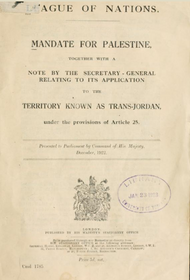British Mandate of Palestine facts for kids
Quick facts for kids League of Nations – Mandate for Palestine and Transjordan Memorandum |
|
 British Command Paper 1785, December 1922, containing the Mandate for Palestine and the Transjordan memorandum
|
|
| Created | Mid-1919 – 22 July 1922 |
| Location | UNOG Library; ref.: C.529. M.314. 1922. VI. |
| Signers | Council of the League of Nations |
| Purpose | Creation of the territories of Mandatory Palestine and the Emirate of Transjordan |
The Mandate for Palestine was like a special permission given to Britain by the League of Nations. This permission allowed Britain to manage the areas known as Palestine and Transjordan. These lands used to be part of the Ottoman Empire, a very large empire that lost many territories after World War I ended in 1918.
Britain was given this job at a meeting called the San Remo conference in April 1920. This happened after France agreed to let Britain take over, changing an earlier plan for international control. Transjordan was added to the mandate after the French took over the Arab Kingdom in Damascus. Britain started its administration in Palestine in July 1920 and in Transjordan in April 1921. The mandate officially began on September 29, 1923. It lasted until May 15, 1948, for Palestine and until May 25, 1946, for Transjordan.
Contents
What Was the Mandate?
The idea for these mandates came from Article 22 of the Covenant of the League of Nations, which was created in June 1919. It also followed a decision made by the main Allied Powers in April 1920. The goal was to help these former Ottoman territories become independent. Britain was supposed to provide "administrative advice and assistance" until the regions could govern themselves.
Setting the Borders
The exact border between Palestine and Transjordan was decided in the final mandate document. The northern border, which separated it from the French-controlled Mandate for Syria and the Lebanon, was agreed upon in December 1920. This helped define the areas Britain would manage.
Palestine Under British Rule
In the part of the mandate called Palestine, Britain had a special task. They had to help create a "national home for the Jewish people." This was part of a promise made in the Balfour Declaration of 1917. At the same time, they also had to consider the Palestinian Arabs, who were the majority of the people living there. This promise for a Jewish home did not apply to Transjordan.
Britain managed Palestine for nearly 30 years. During this time, there were many protests and conflicts between the Jewish and Palestinian Arab communities. Both groups developed strong nationalist movements, wanting their own self-rule.
Growing Tensions and Conflicts
The disagreements between the communities led to serious events. These included the 1936–1939 Arab revolt in Palestine and later the Jewish insurgency in Mandatory Palestine from 1944 to 1948. These were periods of significant fighting and unrest.
The End of the Mandate
To try and solve the problems, the United Nations Partition Plan for Palestine was approved on November 29, 1947. This plan suggested creating separate Jewish and Arab states. It also proposed that Jerusalem would be managed by the UN.
Just two weeks later, Britain announced that its mandate would end on May 15, 1948. On that very day, the Jewish community declared the creation of the State of Israel. After the UN plan was not fully carried out, the 1947–1949 Palestine war broke out. This war resulted in the division of Mandatory Palestine among Israel, the area that became the Jordanian annexation of the West Bank, and the Egyptian-controlled Gaza Strip.
Transjordan's Path to Independence
Transjordan was officially added to the mandate after a meeting called the Cairo Conference (1921) in March 1921. At this meeting, it was decided that Abdullah bin Hussein would govern the territory. He would do so under Britain's supervision as part of the Palestine Mandate.
Before this, Transjordan had been managed by a joint Arab-British military group from Damascus. After the French defeated Abdullah's younger brother Faisal's army in July 1920, Transjordan became a less defined area. Britain then decided to connect it more clearly with the Palestine Mandate.
Steps Towards Self-Rule
The addition of Transjordan was made legal on March 21, 1921, when Britain added Article 25 to the Palestine Mandate. This article was put into action on September 16, 1922, with the Transjordan memorandum. This document created a separate "Administration of Trans-Jordan" under Britain's general oversight.
In April 1923, even before the full mandate began, Britain announced it would recognize an "independent Government" in Transjordan. This self-rule grew even more with a treaty signed in February 1928. Finally, Transjordan became a fully independent country with the Treaty of London (1946) on March 22, 1946.

